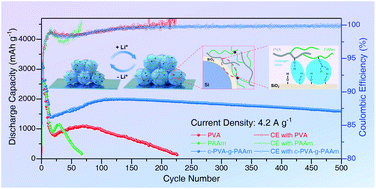Molecular design of a multifunctional binder via grafting and crosslinking for high performance silicon anodes†
Abstract
Silicon (Si) anodes are urgently required in the pursuit of high-energy-density batteries yet plagued by their large volumetric changes and the resultant fast capacity decay. The consensus is that polymeric binders are crucial to effectively secure the electrode integrity against repetitive lithiation/delithiation cycles. Herein, a molecular design of a multifunctional network is presented, created by grafting acrylamide (AAm) monomer onto poly(vinyl alcohol) (PVA) chains, followed by crosslinking to form a 3D network. In this design, the strong PVA backbone binds tightly to the Si surface with its hydroxyl groups, whereas the highly stretchable polyacrylamide (PAAm) branch endows the binder with adequate flexibility and improved Li+ conductivity. After proper optimization, the Si anode using the c-PVA-g-PAAm binder exhibits improved mechanics and surface chemistry. Thus, a high discharge capacity of 1590.5 mA h g−1 has been achieved after 500 deep cycles at a current density of 4.2 A g−1 (1C), corresponding to a capacity retention of 75.9%. At a high rate of 20C, the Si electrode is able to deliver a capacity of 2141.64 mA h g−1.

- This article is part of the themed collection: Journal of Materials Chemistry A HOT Papers


 Please wait while we load your content...
Please wait while we load your content...